Hear ye, hear ye! The VM Analytics Collector now comes in a new flavor! And OVA! Yay! I understand this is more of a “about time, why didn’t you have this in the first place?” kind of a thing, and fair enough, but here we are.
Now the current OVA is somewhat a shadow of what we expect it to be, a lot of the work that went into this was to build the ground work to use this for many other things. So certainly expect this to be developed and offered in more advanced and flexible ways. But for now, it is an OVA that is locked down that contains one thing: the collector.

No, not that collector. The vCenter collector for our VM Analytics tool.
For the uninitiated, VM Analytics is a tool where we pull in your VMware environment details (VMs, VMDKs, hosts, datastores, clusters, etc.) and their performance metrics (Latency, CPU, IOPS, memory, throughput) and send it back to Pure1. From there we then show a nice layout of the environment and how it maps back to the Pure Storage arrays/volumes and the respective metrics across the stack. This is something we are heavily investing in as announced at Accelerate a few weeks back.
So a few of the typical Q&A things:
Q: I already have the collector running, do I need to replace it with the OVA?
A: No. There aren’t really any new features in it yet, so if things are working you are fine. We are end of life-ing the previous collector, so at some point you should make the move. Though we will support the previous incarnation, like many support issues will end with “deploy the OVA”.
Q: What the requirements?
A: Must be deployed to vCenter 6.5 or later. While we support collecting from vCenter 6.0 we have seen a lot of issues with OVA deployments in older vCenter releases. It supports all currently supported Purity releases. Everything else is the same, needs TCP 443 access to Pure1 directly or via a proxy. More info here: https://support.purestorage.com/Pure1/Pure1_Manage/003_Analytics/Pure1_Manage_-_VM_Analytics
Q: What about the on-array collector?
A: The on-array collector will no longer be updated and will be end of life. For new features, you will need to deploy the OVA version moving forward.
Download/Deployment
So where do you download it? Well two options. Log in to Pure1. Then click on VM Topology, then the gear icon.

A window pops up
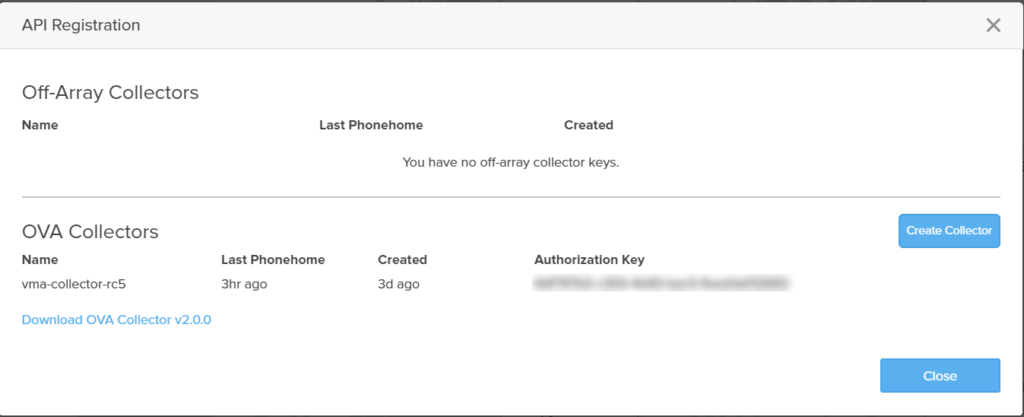
You can either download it from here or you can copy the link (the link from Download OVA Collector vX.X.X). Basically if your vCenter has the ability to download from the internet (or specifically Pure1) then you can copy the link. If it does not have network access, or its network access is slow, then download it and transfer it as needed.
Or you can skip the above and use this link as well.
Deployment
You can automate this easily with PowerShell too: https://www.codyhosterman.com/2019/10/deploying-the-pure1-vm-analytics-collector-ova-with-powershell/
Okay great. Now login to the vSphere Client. Right-click on a host or cluster and choose “Deploy OVA Template…”.

If you copied the link, just paste it into the URL. If you downloaded it, point it to the file directly.
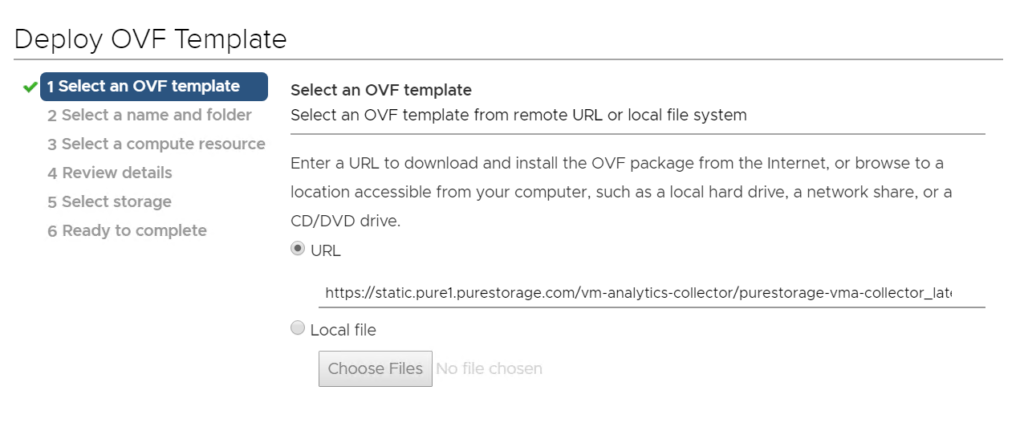
Accept the thumbprint:

Give it a name and choose a datacenter/folder.

Then a host/cluster:

Verify the OVA:
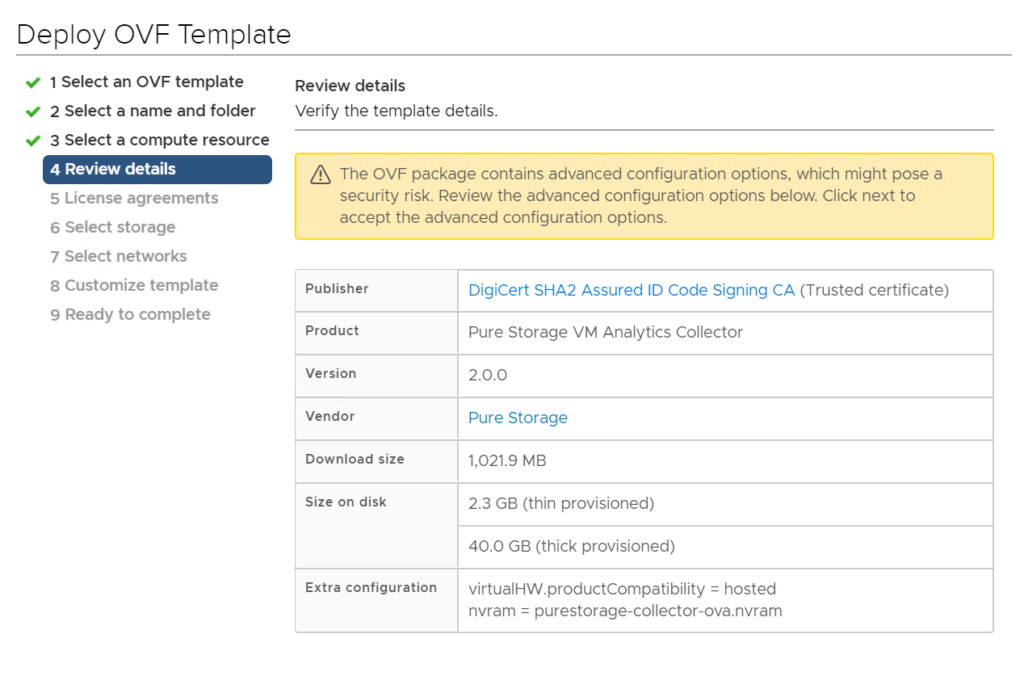
I have seen this part fail in the flash/flex GUI before. Either due to certificate stuff or just some GUI bugs in the vSphere UI. If you are on 6.5 U2 or later you should be fine with the HTML-5 interface. If it fails from the network link, just download it and do it from local. Or upgrade 🙂
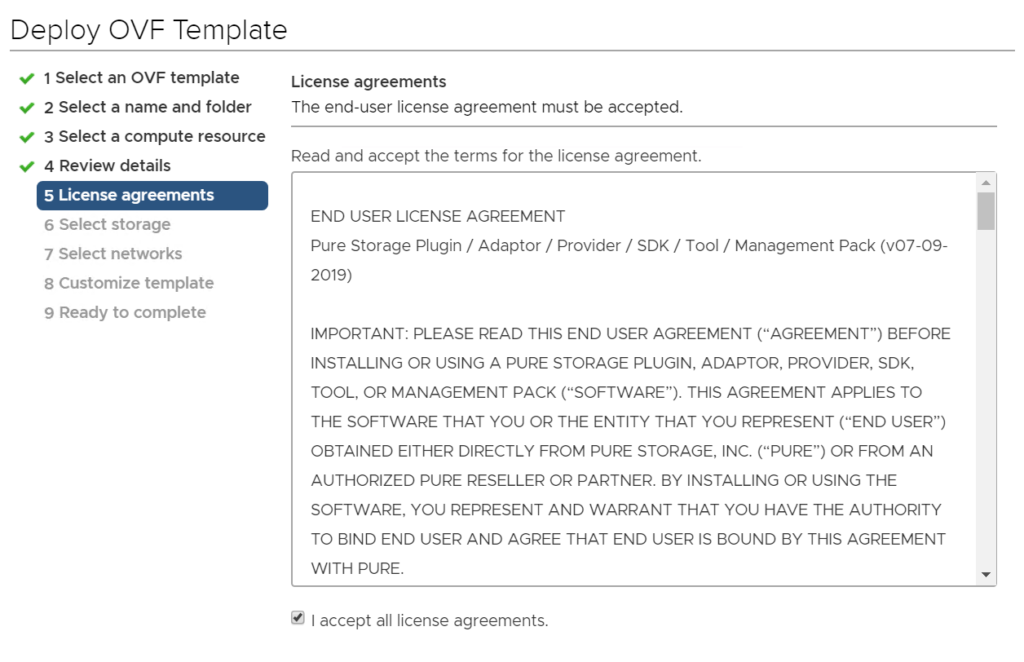
Choose your storage/network etc.
Now you need to enter in your information. The first thing is the authorization key. This is what allows the collector to talk to Pure1. You get this from Pure1. So log back into Pure1 and go back to the gear icon in the VM Topology screen.
Click Create Collector under the OVA portion.
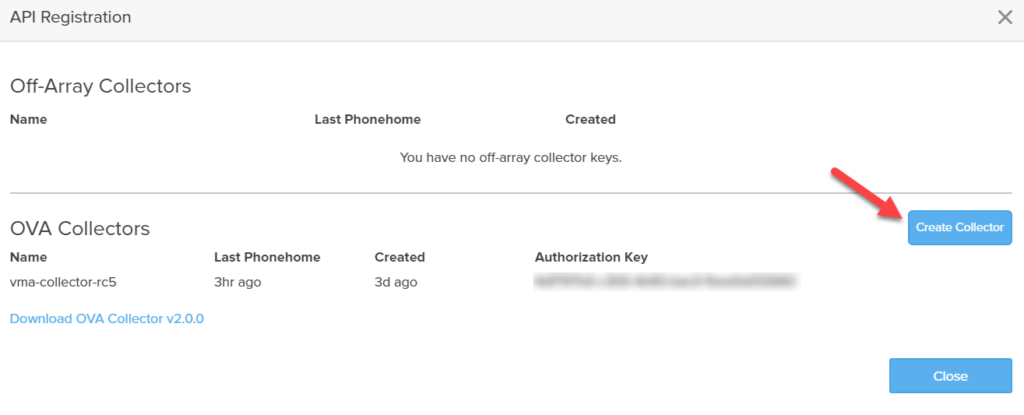
Give it a name and click Create Collector again. This name does NOT have to be the same as the OVA/VM host name. Though it makes sense to do so. Make it descriptive.

This will create a key.

Copy it.

Now go back to the OVA and enter it in the first blank.
If you are using DHCP leave that box checked and continue on. Or de-select it and fill in the IP information.
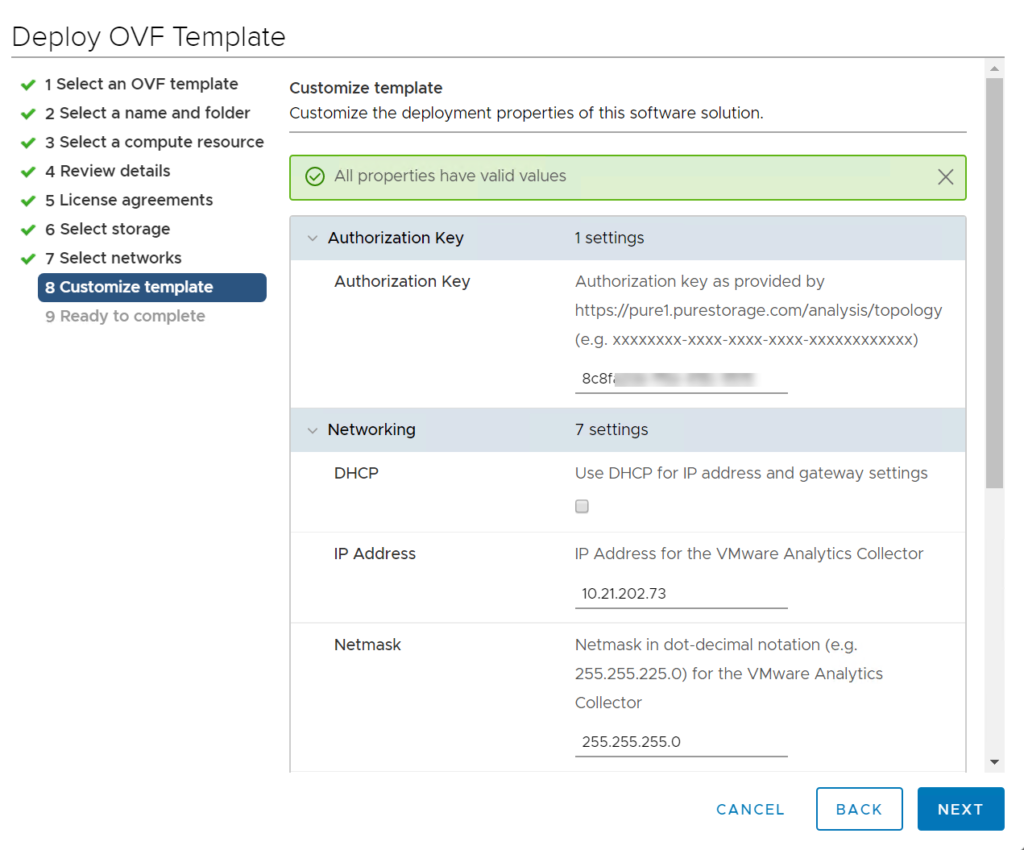
Click Finish and let it deploy.

If this fails, it will fail immediately. The most common reason (or really only reason I know of) is a host certificate is not known. Besides signing/importing the certificate, the simplest workaround for this is directly deploying it to a host (don’t choose the cluster, choose a host)

And before you click Finish navigate to that host in the browser and accept the certificate, or import it to the browser manually. Make sure what you type into the browser is the exact same as what ESXi shows. If it shows, esxi-01, do that, if it shows esxi-purecloud.com, do that, if it says 10.21.202.21, do that.

So accept and finish the deployment.
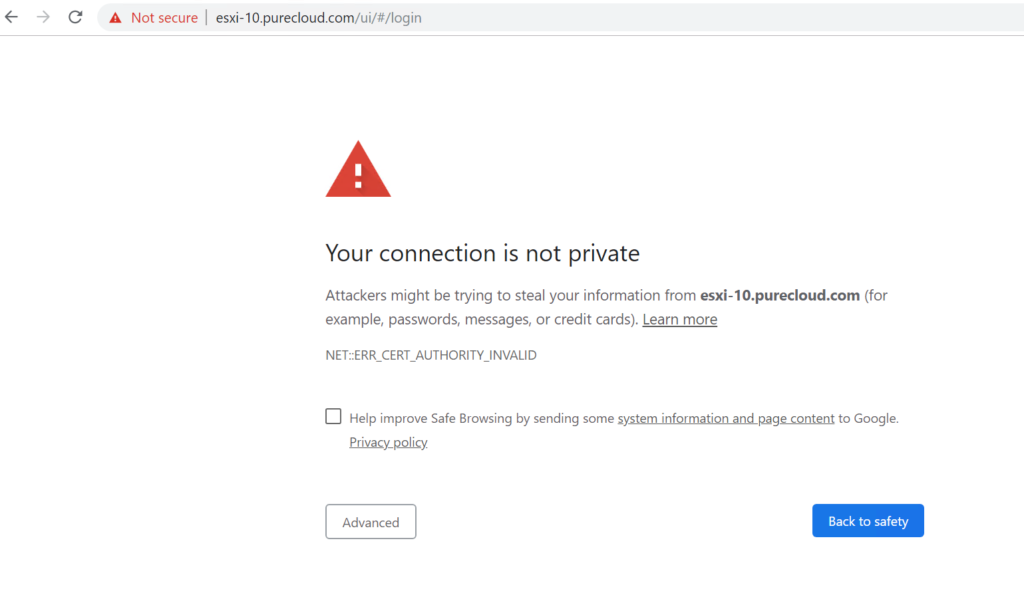
Now go ahead and power it on.

Now go ahead and SSH into it.

Upon first login the username/password is pureuser/pureuser. You will be required to change that upon first login.

The environment is fairly locked down. The only commands available are purevmanalytic and pureadmin ones.
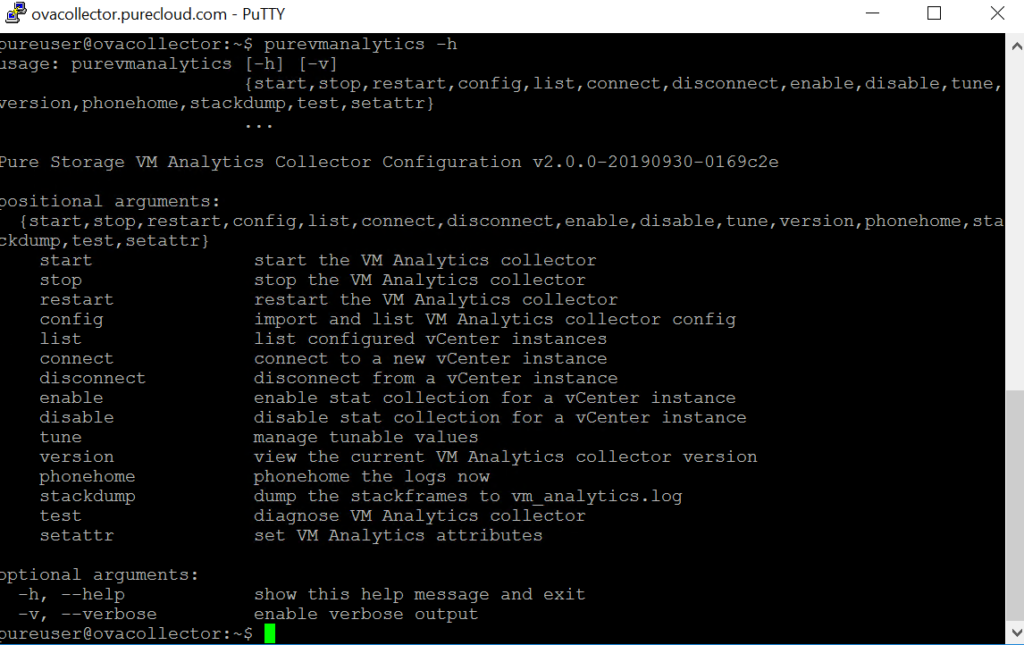
The first thing you want to do is test that it can ping home.
purevmanalytics test pinghome

If it is not successful, the networking was misconfigured or there is a firewall or proxy issue. If you use a proxy, you can set it with the purevmanalytics setattr –proxy command.
Now connect your vCenter(s). This only needs read only credentials, though that or higher will work.

If you don’t specify a name it will just use the host name. You are good to go!

Heck yeah!
Cody,
I have deployed the OVA and configured everything, but I am not seeing anything in the VM Topology screen in Pure1. Will it take some time?
I have tested the pinghome successfully and have connected it to my vCenter host successfully. Is there anything else I need to do to make it work?
It dials home every hour. And for the first time it can take two hours for things to really start showing up. So all you should have to do it wait now
I see now on another post that it could take a couple of hours. I will just let it run and see.
Was just concerned because it still says No VMware clusters found.
Yeah until data appears it will continue to say that
Yes! This is awesome. Thank you.
Hi Cody, is VVOL supported?
We are doing this work in Q4, so unless something dramatic happens, look for support next year.
Cody,
It appears that we no longer have root level access within the OVA.
How does the system stay current with updates?
Patrick
Sorry for the delay, I thought I responded to this. Obviously did not. Updates to the OS and relevant patching will be managed by us. Initially this will be through deploying a new collector and moving the config over to it. Not ideal, understood. This is v1 of the OVA though as we have bigger plans for it so we are working on update delivery/multiple use of the OVA so that update process will be come. For now, if there are critical updates we will bundle them in a new OVA version. It is one of the reasons we do not provide access to the OS–we can ensure what is there so we know what to patch.
Cody,
Are you saying that if there are system updates that need to be applied that we would have to download and install another OVA?
For version one, yes.
We utilize zscaler pac file for proxy access. Is ther any way to configure this or do I need to punch a hole in or firewall for this appliances address?
I can not ssh connect to the OVA VM, I just can login from console. is there anyway I can check the network configuration ?
Did you assign static IPs or DHCP? Today there is no IP query information directly in the OVA, though it can be pulled via VMware tools. So if DHCP, then use VMware tools to see what the IP information is. If there is none, then that means the wrong virtual network was assigned to the VM. If you did static, you can verify what you entered via the API. So this is simplest enough in PowerCLI
$vm = get-vm “ova collector VM name”
$vm.ExtensionData.Config.VAppConfig.Property
This will show you the values entered. The “value” property will be what you are looking for. If something is wrong the simplest option is to just re-deploy. This will be changing in the future of course.
I subscribe to the Purity//FA Release Announcements forum thread, which works great, but I am trying to find a way to keep up with new releases for the OVA Collector.
As far as I can tell, this is the only location to find release notes:
https://support.purestorage.com/Pure1/Pure1_Manage/001_Overview/000%3A_Pure1_Manage_Release_Notes
Is there any other way?
As far as I am aware that is it. I am working on a better way to notify of new releases though. So if you have any preferences, certainly let me know! Thanks
Hi,
My OVA is stuck in the changing password step. When I’m prompted to change it, I do but always it ask me for the default pureuser password :-/ No change made
Hmm this is not something I have seen. Upon first login it will ask you to change the pureuser user account password to something else. Then from that point on you still use pureuser but with the new password. So if it keeps asking you to change the password something went wrong. I’d recommend opening a ticket with Pure support. Beyond that the only troubleshooting steps I can recommend besides that would be trying doing it from the VM console in the vSphere Client and via SSH to see if one way works for you. Let me know.
Hi again! Well, I solved my issue. We try again today from another site, through another ISP Provider with the VPN (like yesterday) and now I have changed the password user at first try. Very rare and strange… But, now is work ok and I’m ready to receive data into my Pure1. Thanks.
how i change the network properties for the collector?
i only see the commands pureadmin and purevmanalytics
At this point no. Just redeploy the OVA with new parameters and then use the import feature to import the vCenter connections into the new one and delete the old. While the OVA is version 2.0.1, it is really version 1.0. The collector itself is version 2.0 really. We have a lot of work to do to get the OVA to a fully featured state. I’ll stipulate to that fact.